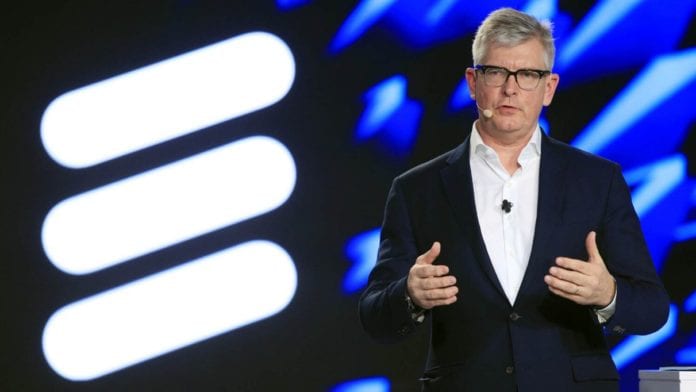Ericsson has warned Europe will fall further behind North America and Asia on LTE and 5G unless governments and regulators act to accelerate the release of new spectrum and licences.
The Swedish vendor, with an early-morning address at Mobile World Congress (MWC) in Barcelona, refused also to take sides on the national security concerning Chinese rivals Huawei and ZTE, but warned security of 5G networks is a industry challenge.
Ericsson claimed more contracts from mobile operators to deploy 5G networks than any other network equipment vendor, and said it is investing heavily in research-and-development to “reclaim” its technology leadership in the market.
“With the industry pivoting to 5G, we set out two years ago to be the market leader and the technology leader based on our focused strategy – to double down on service provider customers, and increase investments in R&D,” said Ericsson chief executive Börje Ekholm (pictured).
He addressed Europe’s perceived tardiness on 5G, and sought to put right the reasons it is falling behind the US and Asia Pacific, citing high spectrum fees and regulatory uncertainty. It has already impacted rollout of 4G LTE systems in the region. He noted certain other “structural inhibitors” delaying LTE and 5G deployments in Europe, including site access and permits.
“A good example, an unfortunate example even, is the 4G situation in Europe. 4G in Europe has much lower coverage than other regions in world.” Where Asia and the North America boast 95 per cent coverage, it is hovering closer to 60 per in Europe, he said.
“With that in mind, it is not a surprise we see the web economy and new companies in the digital economy dominated by the Chinese and American tech giants. With 4G, there was a clear first mover advantage, and we see the same thing in 5G.
“Consumers and enterprises are waiting for 5G… Today, Asia and North America are leading the way. Service providers and governments on the sidelines run the risk of being surpassed by faster moving operators and countries. The stakes have never been higher.”
Ericsson has 10 contracts for 5G – more than any other vendor, it said – across North America, Europe, and Asia. It also cited with 42 memorandums-of-understanding on 5G deployments with mobile operators and industrial partners. “We are truly switching on 5G in 2019,” said Ekholm.
He said Ericsson customers are primed to move to 5G, with its LTE systems 5G-ready since 2015. “Our customers are positioned to move fast… As 5G becomes a commercial reality, we have the capacity, resources, supply chain, geared for fast deployment.”
At the same time, LTE will continue to serve stretching requirements for capacity. “4G is a critical infrastructure for a long period to come,” said Ekholm. Ericsson reckons 60 per cent of subscriptions will still be LTE based at the end of 2024.
The company also claimed “more than half” of LTE-M and NB-IoT networks, globally, and 3,500-odd enterprises making use of its low-power wide-area radios. The market for cellular IoT connections will grow at 27 per cent per year through to 2024, to reach four billion connections, reckons Ericsson.
Ericsson has hired over 4,000 engineers and “aggressively” cut costs in order to “reclaim” its technology leadership, with a strategy of “disciplined growth”. The company will invest around 16 per cent of sales revenue (SEK35-38bn; $3.7-$4 billion) back into R&D, it said. “That’s the level at which we can drive innovation,” he said.
Ekholm made clear the early running in 5G will be, effectively, a go-faster version of LTE for consumers. The real revolution will come in the industrial market, and as massive machine-type (mMTC) and ultra-reliable low-latency (URLLC) communications, as prescribed in the 3GPP’s Release 16 specifications, come available after 2020.
But a central message of the MWC address was on security. Ericsson will stay out of the conversation on the political intrigue around 5G as “vital national infrastructure”, a reference to Huawei’s travails in various markets, and leave it to national governments.
“In the context of the growing debate about national security tied to cell phone networks… [these are] critical decisions for nations. Let me be clear: Ericsson does not have a view on that, nor should [it have]. It is up to nations to decide how to drive national security policy.”
At the same time, he said operators, investing heavily in new infrastructure, are “concerned”, and that the “uncertainty impacts them”.
He returned to the challenge of securing 5G networks, and notably the GSMA’s proposal on a pan-European “assurance testing and certification regime” to assure operators. The issue of security, he observed, does not just come down to embedded software in the core network, but to the broader ecosystem, taking in chipsets, modules, devices, connectivity protocols, and edge and cloud layers.
Ericsson, like others, conducts software testing in the development phase, and gains instant feedback to fix issues as part of the process. The notion of post-development testing is an “insufficient tool”, he said. “It only tests limited representation of networks, and doesn’t include products, protocols and whatever else goes into the network. We believe post-development testing runs risk of a false sense of security.
It also risks slowing down innovation, delaying time to market, including new security updates, and higher costs , as a result. ”Modern software development builds on continuous deployments of new releases and functionality,” said Ericsson in a statement.
“In particular critical 5G use cases, such as autonomous driving and manufacturing, will potentially require expanded scope of testing further slowing down the development of new industrial business cases.”
Ericsson has announced the acquisition of antenna and filters business Kathrein for €270 million to complement its own capabilities in 5G antennas. The company has also launched nine new radios at MWC, including for dual-band, triple-band and massive MIMO.

